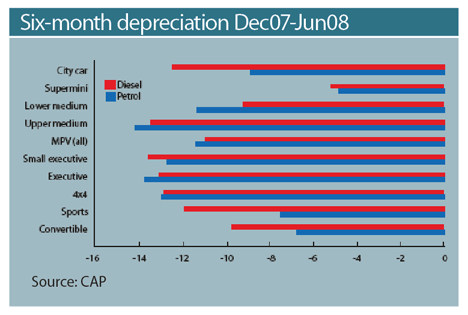Review
The last six months may give us some indication as to whether recent scare stories have any real substance, as well as helping to pinpoint some of the key trends underlying the market.
It was not uncommon to see values rise into January as dealers followed a typical seasonal pattern of liquidating stock in December and actively buying as the New Year started.
However, this year was different.
Used values in early January remained relatively weak, leading to an average 1.6% drop, in contrast to the average 0.5% increase seen in the previous three years.
Feedback suggested a greater willingness for the trade to keep stock over the Christmas period.
February through April saw used car prices follow a vaguely seasonal pattern, with three-year/60,000 mile values dropping by 3.4% – not dissimilar to 2006 and 2007.
May, however, saw a significant downturn, with average three-year values dropping by 2.6%.
This has continued into June, with the average 4.2% drop being the largest average monthly price movement for years.
Other factors also need to be considered.
Stock volumes have been rising for some time which has certainly helped depress values.
This is exacerbated by continuing high levels of pre-registrations.
Other factors include changes in Vehicle Excise Duty legislation and ever-increasing fuel prices.
The new VED policy announced in the Budget will, if implemented, dramatically reduce the value of perfectly serviceable cars, as the cost of 12 months’ tax represents a large portion of the vehicle’s value.
This will drastically reduce the car’s lifecycle as prohibitive VED costs could reduce cars to scrap value.
So, although we cannot be certain that this recent downturn can be fully attributed to the credit crunch, CAP is certain that the ubiquity of negative press speculation will lead to changing buyer behaviour.
Indications are that some people are adopting a wait and see approach.
Also, the particular dynamics of the used market means people can remain active buyers while simply varying their choice to suit their financial circumstances.
Some of these buying behaviours are already evident.
The supermini sector has consistently had the most buoyant used residuals for more than a year.
The AM Index shows that 05/05 plate superminis have depreciated by an average 4.9% over the past six months, with petrol’s 4.8% slightly outperforming diesel’s 5.2% depreciation.
This represents less than half the market average.
The only other sectors where recent depreciation is less than the market norm are city car, sports and convertible sectors.
Petrol city cars’ average 8.8% depreciation over the past six months is additional evidence that vehicle size is increasingly relevant as buyers opt for the more environmentally- friendly option, and seek to minimise the financial cost of motoring.
The convertible sector’s average six month depreciation of 6.9% benefits slightly from the usual seasonal buoyancy.
Just as the smaller vehicle sectors have outperformed the market, those sectors which have seen values drop the most are the larger variants: upper medium, executive and 4x4.
Upper medium values have dropped by an average 14.2% for petrol, and 13.4% for diesel, continuing evidence that retail demand in larger vehicles still favours oil-burners slightly.

Factsheet
No information available.













Login to comment
Comments
No comments have been made yet.